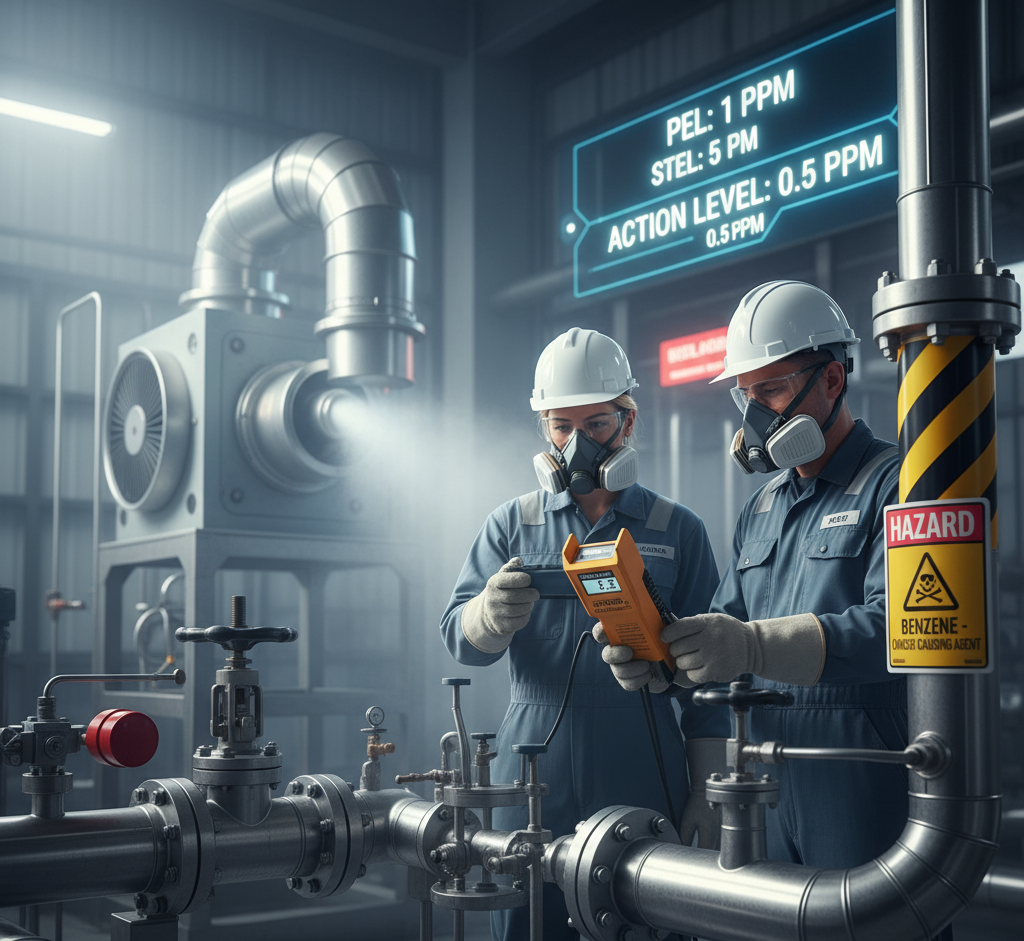
Benzene is a colorless or light yellow liquid at room temperature. It is a highly flammable substance with a sweet odor and is one of the most basic petrochemicals. It is widely used in industries around the globe, yet it poses one of the most serious occupational health risks. As a vital resource for professionals in Health Safety and Environment this comprehensive guide aims to illuminate the hazards associated with benzene exposure and outline the stringent control measures necessary to safeguard worker health. Understanding the risks associated with this ubiquitous chemical is the first essential step in creating a safe and compliant working environment.
Health Effects The Systemic Dangers of Benzene Exposure
Benzene is classified as a human carcinogen primarily impacting the blood forming organs. Exposure can result in a wide range of acute and chronic health effects the severity of which depends on the concentration the duration and the route of exposure.
Carcinogenic Effects
The most serious long term health outcome is leukemia. Benzene exposure particularly at high levels or over prolonged periods is strongly linked to the development of Acute Myeloid Leukemia AML. This is a cancer of the blood and bone marrow. The mechanism involves damage to the bone marrow cells which affects the production of healthy blood cells. It is this known capability to cause cancer that mandates the strict regulatory and control requirements for benzene in the workplace.
Blood and Immune System Disorders
Chronic exposure even to relatively low levels of benzene can severely harm the bone marrow the site of blood cell production. This can lead to a condition known as aplastic anemia where the bone marrow stops producing sufficient new blood cells red cells white cells and platelets. Other serious blood disorders include:
▪️Pancytopenia A decrease in all three types of blood cells.
▪️Thrombocytopenia A decrease in platelets which impairs clotting.
▪️Agranulocytosis A reduction in infection fighting white blood cells leaving the body highly vulnerable to illness.
Acute and Immediate Effects
High level, short term exposure such as through accidental spills or uncontrolled vapor release can cause immediate effects primarily targeting the nervous system. These include dizziness lightheadedness headache tremors and loss of consciousness. In extreme cases high concentration inhalation can lead to coma and death due to respiratory failure. Benzene is also an irritant causing irritation to the eyes skin and respiratory tract upon contact.
Sources of Exposure in the Workplace
Benzene is a foundational industrial chemical and a natural component of crude oil. Consequently workplace exposure is common across numerous sectors. Identifying these sources is paramount for implementing effective control strategies.
Petroleum and Petrochemical Industries
This sector represents the most significant source of occupational benzene exposure. Workers are exposed during:
▪️Crude Oil Refining and processing where benzene is extracted or is an intermediate product.
▪️Transportation and Storage of gasoline and crude oil including tank gauging pipe repair and barge loading or unloading. Gasoline itself contains low levels of benzene.
▪️Sampling of chemical streams in laboratories or process units.
Manufacturing Industries
Benzene serves as a crucial starting material for producing a variety of other chemicals and materials. Exposure can occur in the production of:
▪️Styrene which is used to make polymers and plastics.
▪️Phenol and Cumene widely used in resins and adhesives.
▪️Cyclohexane used as a solvent and in nylon production.
▪️Rubber Products and Tires where benzene may be used as a solvent or found as a contaminant in raw materials.
Other Industrial Uses
Workers in the following fields may also face exposure:
▪️Laboratories handling benzene as a solvent or reagent.
▪️Shoemaking and Leatherwork where it was historically used in certain glues and degreasing agents although this practice is now heavily regulated.
▪️Maintenance and Repair of equipment contaminated with benzene containing products.
The primary route of entry into the body is inhalation of vapor but significant dermal absorption through skin contact with liquid benzene can also occur.
Permissible Exposure Limits PEL Strict Regulatory Control
Due to the severity of its health effects particularly its carcinogenic nature regulatory bodies globally have established extremely strict limits for occupational exposure to benzene. These limits dictate the maximum concentration of airborne benzene workers can be exposed to over specified time periods.
Time Weighted Average TWA
The TWA represents the average concentration a worker can be exposed to over an eight hour workday and a forty hour work week. The standard TWA for benzene in many jurisdictions including the United States Occupational Safety and Health Administration OSHA is 1 part per million ppm. All workplaces must ensure that the exposure of their employees does not exceed this level on average.
Short Term Exposure Limit STEL
The STEL is designed to protect workers against acute effects and irritation resulting from short duration exposures. This limit specifies the maximum average concentration over a fifteen minute period. The typical STEL for benzene is 5 ppm. This higher limit acknowledges that brief excursions above the TWA are sometimes unavoidable during certain non routine tasks but they must be carefully controlled and monitored.
Action Level
Many regulations also define an Action Level often set at 0.5 ppm averaged over eight hours. When exposure measurements reach or exceed this level employers are required to initiate specific compliance measures such as increased monitoring enhanced medical surveillance and detailed hazard communication to workers. Compliance is not optional it is a legal and ethical requirement for protecting worker health from this proven carcinogen.
Personal Protective Equipment and Ventilation Controls
Controlling benzene exposure relies on the hierarchy of controls with engineering and administrative measures taking precedence over personal protective equipment.
Engineering Controls Ventilation
The most effective method for controlling benzene vapor is through robust engineering controls designed to eliminate or minimize its release into the breathing zone.
▪️Enclosure and Isolation: Process units containing benzene should be fully enclosed and isolated from work areas wherever feasible.
▪️Local Exhaust Ventilation LEV: This involves installing dedicated systems near the source of emission such as tank openings or sampling points. The LEV captures the contaminants at the source before they can disperse into the general work atmosphere.
▪️General Dilution Ventilation: Used to maintain airflow and dilute any residual vapors in the work area to below the permissible exposure limits.
Personal Protective Equipment PPE
PPE is the last line of defense used only when engineering controls cannot fully reduce exposure below the PEL or during non routine tasks such as maintenance or emergency response.
▪️Respiratory Protection: Depending on the measured or anticipated concentration appropriate respiratory protection is mandatory. This can range from half mask or full face air purifying respirators with organic vapor cartridges to supplied air respirators or self contained breathing apparatus SCBA for high concentrations or confined space entry. Respirators must be selected as per an established respiratory protection program including fit testing and medical clearance.
▪️Skin Protection: Since benzene can be absorbed through the skin chemical resistant clothing and gloves are essential. Gloves made of materials like Viton or Silver Shield offer superior protection compared to natural rubber or neoprene. A thorough glove permeation testing and selection process must be in place.
▪️Eye Protection: Chemical splash goggles or full face shields are required to prevent liquid splashes or high concentrations of vapor from irritating the eyes.
Importance of Medical Monitoring
Because benzene primarily targets the blood forming system regular and comprehensive medical monitoring is a cornerstone of any effective benzene safety program especially for employees with the potential for regular exposure at or above the Action Level.
Pre Placement and Periodic Examinations
▪️Initial Baseline Assessment: A thorough medical history and physical examination is required before a worker begins benzene exposure work. A complete blood count CBC with differential is performed to establish a baseline of the worker's blood health.
▪️Annual Periodic Examinations: Workers must undergo a CBC with differential at least annually. This test looks for early signs of adverse blood changes such as decreases in red or white blood cells or changes in platelet counts which may indicate bone marrow suppression due to benzene. The results are compared to the worker's own baseline and to established reference ranges.
Termination and Emergency Monitoring
▪️Exit Examination: A final medical examination and CBC should be provided when an employee terminates benzene exposure work.
▪️Exposure Response: In the event of a significant or acute exposure the affected worker must receive immediate medical attention and follow up monitoring as determined by a qualified occupational health physician.
Role of the Physician
It is critical that the occupational health physician responsible for the program has detailed knowledge of benzene toxicology and exposure standards. The physician must review all test results and communicate any abnormal findings to the employee and the employer along with recommendations for follow up or removal from exposure if necessary. This medical surveillance is not merely a formality it is a life saving early warning system for a chemical whose damage can be irreversible.
Conclusion
Benzene awareness is not simply about complying with a regulatory checklist it is about recognizing and respecting the severe health hazard posed by a powerful industrial solvent. The long term consequences of exposure including leukemia and other irreversible blood disorders demand an unwavering commitment to safety. By diligently implementing engineering controls providing the correct Personal Protective Equipment rigorously adhering to Permissible Exposure Limits and maintaining a robust medical monitoring program companies uphold their fundamental duty to ensure that no worker sacrifices their health for their job. A culture of safety and vigilance is the only acceptable control measure when dealing with a silent killer like benzene.
 Athenatus Ricky
Athenatus Ricky